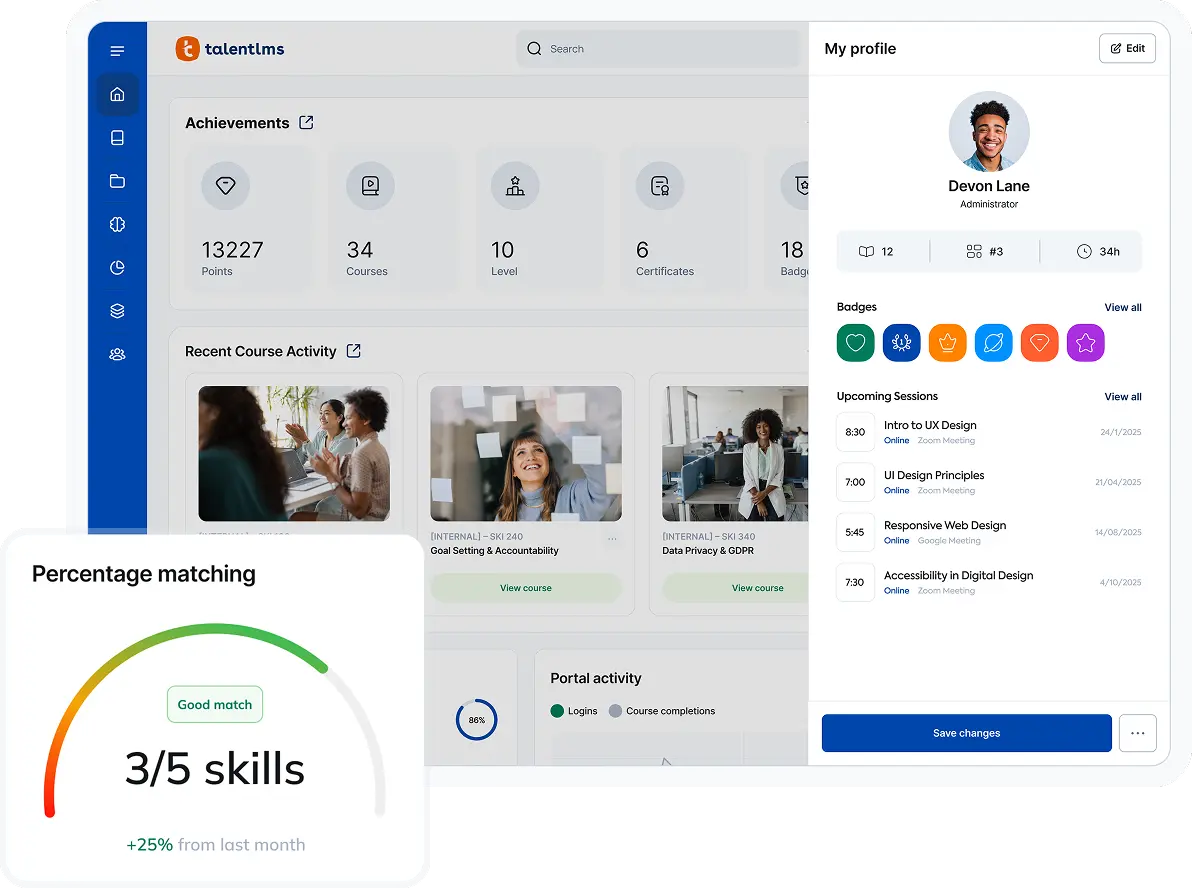Actions speak louder than words. In the workplace, this translates to a simple truth: skills perform, and knowledge speaks.
What this means for businesses is that to get the best out of your employees, you should invest in upgrading their skills, not just their knowledge. Doing so opens up a whole new world of opportunity for employees and employers.
In this article, we examine skills-based learning and its importance, as well as its benefits and challenges, skills-based activities to explore, and how you can create your own skills-based learning program.
What is skills-based learning?
Skills-based learning is about developing practical, real-world skills that apply to a job or industry. An example would be time management skills, which help employees arrive to work on time, end meetings on the dot, finish tasks diligently, and more.
While knowledge is undoubtedly important, skills are what enable a person to put that knowledge into action. Without the skills to carry out the knowledge, the knowledge is like a ship in the harbor, kind of purposeless.
For example, a person may have knowledge of project management methodologies, but without the skills to properly plan, organize, and execute projects, that knowledge isn’t going to be of much use.
Skills-based learning helps to bridge the gap so that you can put that shiny boat into action.
Here are two skill-based learning examples:
- Instead of simply reading about coding languages as part of technical skills training, software developers can join coding bootcamps where they work on real projects. They build real apps, work with teammates on platforms like GitHub, and solve real coding challenges.
- Nursing students often take part in on-the-job training at local hospitals. They practice patient care techniques, learn to use medical equipment and handle emergency scenarios in a controlled environment.
Skill-based learning vs knowledge-based learning
The traditional approach to learning has mostly been knowledge-based.
Knowledge-based learning is about acquiring information, facts, and theoretical concepts. To do this, lessons are often long and academic in nature, with lectures, textbooks, and tests.
This method of learning helps build a foundation of knowledge but fails to prepare learners for real-world scenarios.
In contrast, skill-based learning is a more “hands-on” and “lived-in” approach that uses skill-based activities to help people learn. Skills-based learning gives learners practical abilities directly related to jobs and careers.
What’s the objective of knowledge-based learning?
The main objective of knowledge-based learning is to build a strong foundation of concepts, principles, and factual knowledge within a particular subject area. Successful learners can participate in knowledge sharing and train employees or become more specialized.
What’s the objective of skills-based learning?
The objective of skills-based learning is to build the necessary skills to perform specific tasks, solve problems, or respond to complex situations successfully.
Key differences between them
The main goal of these two learning styles isn’t the only thing that sets them apart. They’re both starkly different from each other in many critical ways. To show you, we’ve broken down knowledge vs skills below.
Outcomes:
- Knowledge-based learning measures the theoretical level of comprehension.
- Skills-based learning measures the ability to perform specific tasks or skills.
Methods:
- Knowledge-based learning often relies on lectures, readings, and discussions.
- Skills-based learning uses hands-on activities, simulations, role-playing, and on-the-job training.
Timeframe:
- Knowledge-based learning can be a more prolonged process, as it requires the acquisition and retention of information.
- Skills-based learning tends to be more focused and targeted, and, therefore, quicker to master.
Application:
- Knowledge-based learning helps people understand concepts and theories.
- Skills-based learning leads directly to improved job performance and productivity.
Retention:
- Knowledge can be forgotten quite easily if not applied.
- Skills, once learned and practiced, are easier to retain for a longer period.
Assessment:
- Knowledge-based learning is typically assessed through exams, quizzes, and written assignments.
- Skills-based learning is evaluated through performance-based assessments, such as simulations, role-plays, and practical demonstrations.
Transferability:
- Knowledge can be more easily transferred from one context to another using frameworks like a knowledge-transfer plan.
- Skills often need to be adapted and refined for different situations or environments.
- Knowledge-based learning can sometimes be more passive and lecture-based.
- Skills-based learning tends to be more engaging and interactive.
Why is skill-based learning important?
Close to 4 in 10 employees believe their current skill set will be obsolete in the future. This implies a discrepancy between what skills employees possess and what their jobs require.
Industries such as Technology, Healthcare, and Finance are particularly vulnerable. For example, the Tech industry requires constant upskilling because of fast advancements in technology. Think about things like AI and how they have changed the demand for skills from developers and engineers.
Similarly, the Healthcare sector demands workers who are up-to-date with the latest skills.
In Finance, the emergence of fintech and blockchain technology has created a need for new, specialized skill sets. It’s no longer a game of accounting but more one of analytics.
In fact, according to Springboard’s research, in industries like Financial Services and Tech, over 73% of leaders acknowledge a lack of necessary skills. This clearly highlights the critical importance of skill-based learning in these fields. However, that doesn’t only apply to these areas.
Having specific skills makes people more attractive to employers. For example, a software developer who has learned communication frameworks is more likely to secure a job than one who cannot collaborate effectively. Similarly, a nurse trained in patient care techniques will have an edge in the job market.
On top of that, organizations that invest in their employees’ professional development see greater retention rates. Research shows that 86% of professionals would leave a company if a new employer offered them more development opportunities.
Skill-based learning isn’t necessarily only for professional development—it also contributes to personal growth, confidence, and lifelong learning.
Advantages of skill-based learning
Skill-based learning offers numerous benefits that traditional learning methods often lack.
A better learning experience
Skill-based learning is inherently interactive and hands-on, which also makes it very engaging and enjoyable. When learners are actively involved in their education, they naturally gain a deeper understanding of the subject matter.
Improved retention and application
Learning by doing not only makes the experience more enjoyable but also aids in better retention of information. For example, an aspiring chef who practices cooking techniques will retain the knowledge better than someone who only reads about them. This principle applies across various fields, such as coding boot camps that teach programming through real projects and medical training that relies on hands-on patient care.
Increased productivity
Skill-based training leads to higher productivity and efficiency at work. For instance, a team trained in agile methodologies can manage projects more effectively, resulting in faster delivery times and higher-quality outcomes.
Better business performance
Organizations benefit from improved performance since employees are more productive. They also benefit from employees who are better able to fulfill their roles than those who have the know-how but not the skills.
Organizations that adopt a skills-based approach are more likely to achieve their objectives.
Flexibility and internal mobility
Having a diverse skill set helps people adapt to new roles or even pivot to entirely different industries.
For example, consider a graphic designer who can easily be groomed into a user experience (UX) specialist through targeted skill development.
Companies that successfully implement internal mobility programs retain employees nearly twice as long compared to those without effective strategies.
Challenges of skills-based learning
Using or creating a skills-based learning program comes with some common challenges that businesses need to be aware of before they burn all their books in favor of practical lessons.
Identifying relevant skills
One of the primary challenges is pinpointing the specific skills that employees need to develop. Because modern businesses have to adapt at a breakneck speed, the required skills can change quicker than you can train them.
Assessing skill proficiency
Evaluating the proficiency of learners in acquired skills can be challenging, especially for employee soft skills or complex technical skills. It is difficult to quantify something like empathy, but almost all types of leaders will need this in their roles.
Traditional ways of testing may not truly show if someone can do a job well. So, organizations need to come up with or adopt better and more realistic testing methods.
Applying the skill
Even after skill-based training, it can be hard for learners to use their new skills on the job. Things like organizational culture, lack of reinforcement, or inadequate support can all slow down the transfer of skills to the workplace.
Resource constraints
It takes a lot of time, money, and people to make a skills-based learning program. Allocating resources like subject experts, trainers, and equipment can be challenging for organizations.
Resistance to change
A skills-based learning tactic may put some people off if they are accustomed to traditional knowledge-only training. Such resistance and lack of alignment on the requirement for continuous skill development can become a huge bottleneck.
Skill-based learning activities
Skills-based learning activities are an integral part of the learning and training process. These activities are designed to give learners a chance to practice and improve their skills in a safe and controlled environment.
eLearning
eLearning can be an easy way to engage learners and build on their skills. It offers asynchronous training opportunities that allow learners to learn at their own pace.
Furthermore, most eLearning activities happen through a learning management system (LMS). This means that all learner progress is centralized making it that much easier to monitor.
Let’s say you have a salesperson on your team who has in-depth product knowledge but can get a bit flustered when presenting to prospective customers. You can assign them relevant presentation skills courses that will help them improve that specific skill.
TalentLibrary – Skills that matter, courses that deliver
With TalentLibrary, you set the foundation for a strong, aligned workforce—soft skills, compliance, and workplace essentials, from day one (and beyond).
Simulations
Simulations replicate real-world situations or environments. They help learners to practice their skills in a realistic yet risk-free setting. These could vary from in-person simulations to highly sophisticated computer-based recreations of actual cases.
Simulations work especially well in skill-building professions such as customer service, sales, project management, and performance management.
On-the-job training (OJT)
On-the-job training is a way to learn skills directly at the workplace. Learners gain insight through hands-on tasks and projects done under the guidance of seasoned mentors.
These are assignments or tasks that employees execute. The projects may include everything from building an actual product or service to writing a business plan or conducting market research.
On-the-job training is very beneficial because it offers the ability to expand on training with real experiences. They not only solidify learning but also develop critical thinking, problem-solving, and project management skills.
Role-playing
Role-playing consists of acting out specific scenarios or situations related to a desired skill. This activity requires learners to practice communication, problem-solving, and decision-making skills.
Role-playing can be used to simulate customer interactions, conflict resolution scenarios, or any situation that requires interpersonal skills.
Steps for a successful skills-based learning strategy
To ensure you design strong, meaningful, and effective learning under the framework of your new skills-based approach, you need to follow several steps.
1. Assess existing skills
The process starts with a thorough skills assessment to understand the current skill levels of your workforce. You can do this using various assessment methods, such as self-assessments, manager evaluations, or skills tests. Look for the critical skills required for each role and determine the proficiency levels of your employees.
A big plus about this assessment is that it will help identify strengths and weaknesses while acting as a baseline to measure progress.
2. Identify skills gaps (perform skills gap analysis)
Once you have a clear understanding of the existing skills, you can identify the gaps between the required skills and the current skill levels of your employees. Use a skills gap analysis to help you identify the skills you need and determine what to prioritize.
3. Plan to upskill and reskill
Based on the identified skills gaps, plan and implement upskilling and reskilling programs to bridge the gaps.
Upskilling focuses on building existing skills, while reskilling is about learning entirely new skills.
Make use of various learning methods, such as instructor-led training, online courses, mentoring, and on-the-job training, to cater to different learning preferences.
4. Measure and adjust
Regularly measure and evaluate the effectiveness of your skills-based learning programs. You can use employee training software to help you collect feedback from participants so that you can assess the impact on job performance.
Use it to track key metrics such as skill proficiency levels, productivity, and employee engagement.
With the data you collect, you can refine and improve your learning strategies continuously.
Closing the skills gap
There is a lot to gain from transforming your business into a skills-focused organization. To maximize this potential, you must:
- Unite stakeholders to recognize skill benefits.
- Lead the company toward a skills-based mindset.
- Adjust L&D and HR procedures.
Organizations that can effectively accomplish this will have the opportunity to tap into larger pools of talent and address the current shortage of skills. However, those who are unwilling to change their mindset will face a considerable disadvantage in the war for skilled workers.
| Tags: skills-based learning





